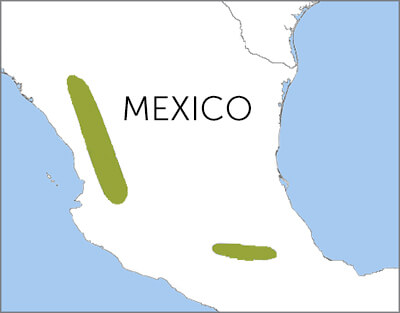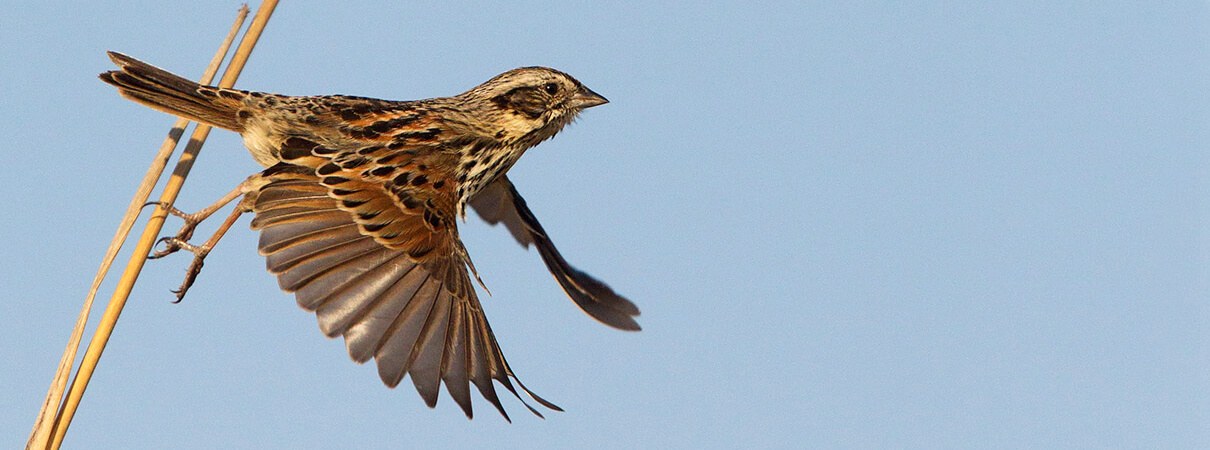
Sierra Madre Sparrow range map, Birds of North America, https://birdsna.org maintained by the Cornell Lab of Ornithology.
The trim little Sierra Madre Sparrow was first discovered in 1889 in the state of Jalisco, Mexico. It resembles a smaller Song Sparrow with more rust color in the wings and tear-drop-shaped spots on its underside, instead of the Song Sparrow's blurry streaks. Both species show a blackish central breast spot.
Running the Gauntlet
As with many other endangered species, the Sierra Madre Sparrow is being squeezed out of its range by unsustainable land use by people, a problem faced by other rare sparrows, including the Worthen's Sparrow, and two subspecies: the “Oregon” Vesper Sparrow and the Endangered "Florida" Grasshopper Sparrow.
The Sierra Madre Sparrow is already restricted to a few small patches of habitat, and threats seem to be coming at this small bird from all directions. In its high and dry habitat of subalpine bunchgrass meadows, water sources are depleted by diversion for use by settlements and ranches. Marsh-edge habitat is also over-grazed, as are many areas of bunchgrass.
In addition, ranchers frequently burn the sparrow's habitat to promote new growth for grazing livestock. While such habitat degradation is an issue, so is outright habitat loss, with grasslands replaced by cropland and new houses. Nesting low in the bunchgrass, often in compromised habitats, Sierra Madre Sparrows experience high rates of nest predation.
Restricted Range
The Sierra Madre Sparrow is found only in Mexico, restricted to bunchgrass habitat in volcanic mountain ranges between 7,500 to 10,000 feet elevation. These grasslands occur on flat valley bottoms near scattered stands of Montezuma Pine, which grow on the surrounding ridges. The sparrow shares its habitat with Bobcats, Coyotes, Volcano Rabbits (also endemic and Endangered), Red-tailed Hawks, Eastern Meadowlarks, Striped and Savannah Sparrows, Strickland's Woodpeckers, and rattlesnakes. Other endemic Mexican birds occurring nearby, although in different habitats, include the Green-striped Brushfinch, Russet Nightingale-Thrush, Red Warbler, Gray-barred Wren, and Hooded Yellowthroat.
Like the Saltmarsh Sparrow and other ground-nesting species, the Sierra Madre Sparrow is secretive, preferring to run rather than fly. During breeding season, however, males perch on tall grass stalks and other conspicuous places, sounding off in a burry, see-sawing song. Listen here:
(Audio: Peter Boesman XC232312. Accessible at www.xeno-canto.org/232312)
One of the Bunchgrass
The female Sierra Madre Sparrow builds her nest of grasses on or near the ground, often tucked into a clump of bunchgrass. Females also carry out all incubation and brooding duties, although both male and female feed the hatchlings. When the chicks fledge, they remain near the nest for a few weeks.

Sierra Madre Sparrow by Manuel Grosselet, Flickr
Like other grassland species such as the Eastern Meadowlark and Sprague's Pipit, the Sierra Madre Sparrow forages on the ground for a variety of insects and seeds. It has been observed feeding in agricultural fields, as well as in nearby pine forest edges.
Getting on the Right Track
Fortunately, a number of studies and surveys have been done to pinpoint remaining Sierra Madre Sparrow populations, and outreach programs that include education and monitoring now involve local communities. Much of the sparrow's remaining habitat falls on communal lands, known as ejidos, so increased local buy-in could work wonders for this vanishing songbird.
ABC works with the Mexican government's National Commission for the Knowledge and Use of Biodiversity (CONABIO) to advance the conservation of Mexican Alliance for Zero Extinction (AZE) species, which are threatened species that only exist in one area. In 2018, CONABIO published a map of Mexican AZE sites, which included the Sierra Madre Sparrow.
CONABIO supports a community-based monitoring and conservation team, the Monitoreo Biológico Milpa Alta, to lead habitat conservation and restoration activities for the Sierra Madre Sparrow. The team monitors the bird's biology and population dynamics, and is actively pursuing community science opportunities and the use of tools, such as eBird, to further conservation efforts for this and other imperiled species.
Donate to support ABC's conservation mission!



















































